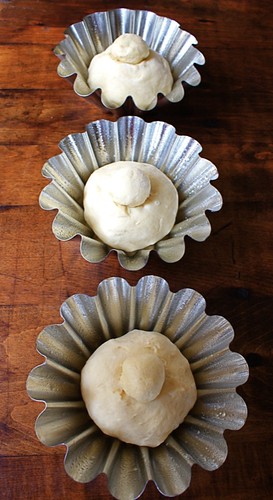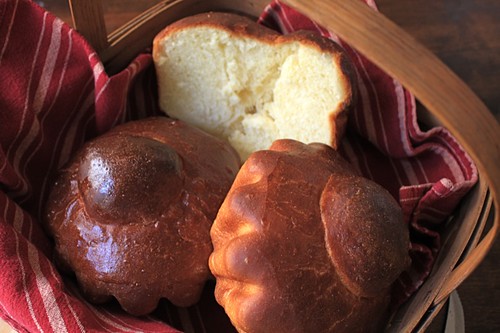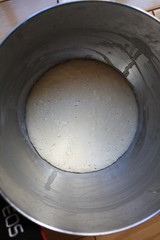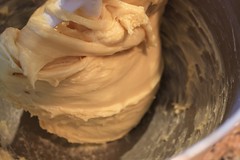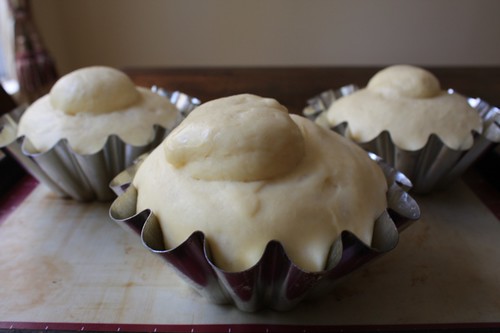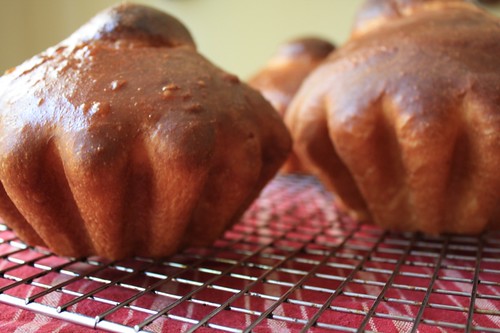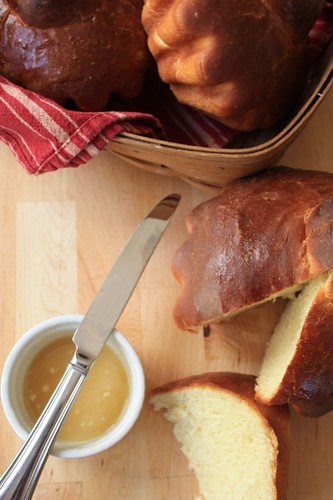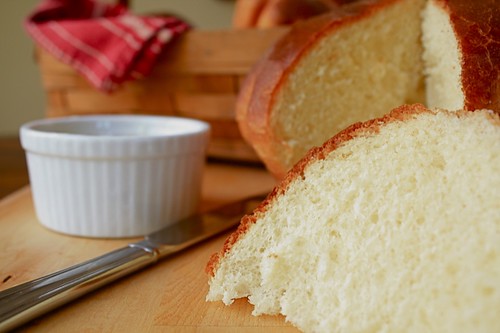Lean Brioche a Tete is Worth the Wait
You’ve seen that movie called Field of Dreams, right? Kevin Costner *sigh, swoon* builds a baseball diamond in the middle of his corn field based on the advice, "If you build it, they will come…" Well, if I had a motto to label my life, that would be it with one caveat: "If I spend it, it will come." Tongue in cheek, of course, but so often, true. I’m an optimist.
So what in hell does this have to do with food or cooking? Everything.
Years ago when we were finally graced with a Williams-Sonoma store, I remember walking past kitchen utensils and tart pans I never imagined existed. My husband and I would venture into the store never intending to purchase anything because it was simply out of our spending range. He’d head back to the olive oil tasting bar which, sadly, is not there now, and I’d stand next to the baking supplies, gazing dreamily at the unique sizes and shapes. If I remember correctly, I’d seen a photo in one of my food magazines of a perfect, golden, fluted brioche and loved the look of it, curious about its shape. So when I saw the 7 x 3-inch silver mold stacked among all the other fancy baking things, I couldn’t resist. I had to have it.
Just one.
You’re laughing, right? Because if you know anything about brioche — or any bread for that matter — there’s no way that one pan, even a large one, would be enough. And reducing any recipe that much isn’t something I’d have taken the time to do — especially with a house full of boys, my husband, and mother to feed.
Life got ridiculously busy, and like many other things I’ve purchased in the past, the brioche mold sat in my cupboard with the other baking items I’ve collected, waiting until the time I might use it — reminding me that some day, just maybe, I’d get around to it.
It’s not that I thought making any kind of bread was challenging, it was more about planning ahead. Most recipes I’d read required overnight refrigeration, and somehow, after dinner each night, the last thing I wanted to do was make brioche.
The pace of my life is slower now — much slower, thankfully, and so I finally purchased two more brioche molds to make my first three loaves of "brioche a tete" (which are probably not called "loaves," right?).
I chose a recipe from Sherry Yard’s The Secrets of Baking because I like the way the cookbook is organized. There’s a master recipe to learn from, and then variations on the master depending on the richness of the dough. Yard’s master brioche recipe is classified as a "medium" with 25% butter as compared to a "rich" containing 40-50% butter. I thought I was making the master recipe, and was fairly involved when I realized I was making the "lean" version which contains 10-15% butter.
My hips and thighs thanked me until I planned to make two desserts with the left over brioche. But I’ll save that for later.
Lean Brioche
Makes 2 lbs. dough
For the sponge…
2/3 c whole milk, at room temp
1/2 oz. fresh yeast or 2 tsp. active dry yeast
1/2 c. bread flour or all purpose flour
1/4 c. sugar
In the bowl of a standing mixer using the paddle attachment, combine milk and yeast. Mix until yeast is dissolved. Add the flour and sugar and mix until thick. Remove bowl from stand, and cover with plastic wrap. Let rest in a warm place for about 30-45 minutes or until bubbles form on the surface.
For the dough…
3 c. bread flour or all purpose flour
1-1/2 tsp. salt
4 lg. eggs, lightly beaten
1/4 lb. unsalted butter, at room temp
For the egg wash…
1 lg. egg
1 T water
pinch of salt
When the sponge is ready, add the flour and salt, then eggs. Mix on low speed until the eggs are incorporated, then on medium speed, mix for 5 minutes. The dough is very thick and may begin to hit the sides of the bowl, so keep an eye on it to prevent the mixer from moving around. A dough hook may help reduce this and can be used instead.
Reduce speed to medium low and add butter 2 T at a time. Make sure to stop periodically to scrape down the sides of the bowl before continuing, about 1-2 times. Knead until dough is very smooth and shiny, at least 5 min. Turn dough out of bowl to completely clean the bowl, dry it, then oil lightly.
After forming a ball with the dough, replace it in the oiled bowl, and turn it to make sure the top is coated with oil. Cover the bowl with plastic wrap and let rise at room temp about 2 hours, or until doubled in volume.
When the dough is doubled in size, punch it down, and then fold it over on itself 2 or 3 times. Replace the dough in the bowl and let rise again until doubled, about 45-60 minutes. You may choose to do the second rise in the fridge, approximately 4 hours, or over night.
Toward the end of the second rise, preheat oven to 400 degrees F and place a rack in the center of the oven. Spray three large brioche molds (7 x 3.5") with oil.
After the second rise is complete, turn the dough out onto a lightly floured board, and divide into three equal pieces, and shape each piece into a tight ball. Cover each with a piece of plastic wrap sprayed with oil and let rest for about 10 minutes.
Roll each piece into a log, and pinch about 1-2 inches from each log and set aside. Shape each log, and each small pinch of dough into a round. Place the large rounds into the molds, then roll each small round into a slight cone shape. With a finger, poke a good-sized indentation into each large round, then position each small cone into the indentation. The goal is to make sure the small top knots stay snugly fit into the large rounds, but sticking out on top like a cherry on a sundae. Cover all with plastic wrap sprayed with oil and let proof in a warm place for about an hour, or until doubled in size.
When the proofing is finished, make the egg wash, and brush the dough lightly over the top.
Bake for 10 minutes, then turn the oven temp down to 350 degrees F and bake for 30 minutes or until each loaf is dark golden in color, has an internal temp of 180 degrees F, and sounds hollow when thumped on the bottom.
Let cool in the molds on a rack for 10 minutes, then remove to cool completely.
Enjoy with butter while it’s warm, or toasted with honey or jam.
Try not to eat it all, because there are lots of great desserts you can make with it!
Notes…
- The dough is very dense and sticky. It’s heavy when the mixer is kneading it, so you really have to watch the mixer, as it will shimmy a bit across the counter, and I have a heavy duty Kitchen Aid.
- Make sure you stay true to the mixing/kneading times. Listen for the slap of the dough against the side of the bowl, and look for the texture called for.
- I did followed the directions to the T, and decided to let the first rise happen at room temp (about 70 degrees F). It took over 2 hours, and even then, didn’t quite look doubled in volume.
- I chose ahead of time to do the second rise in the fridge over night, making sure to cover the molds with plastic wrap sprayed well with oil. I expected to see a spongy mess in the morning, but didn’t, and again, I was stretching to see that it was doubled in volume!
- The dough isn’t light and fluffy. It’s heavy, and very silky to the touch. Quite beautiful, actually.
- Because I refrigerated my dough for the second rise, I had to expect a longer time to rise in the molds — more than 2 hours again to get it to fill the pan at room temp.
- The brioche baked for 7 min. on the first hot setting, then only 25 min. on the second setting.
- Because the brioche was browning very quickly, with 15 min left, I reduced the temp by 10 degrees to 340 to finish, and still took it out sooner.
- I used an instant read thermometer, removing one loaf from the hot pan (how strange is this?) and sticking it in the bottom until it read 180 degrees F, totally surprised that it actually worked. Such a doubting Thomas at times…) And I thumped the bottom to listen for the hollow sound before
dropping itgently replacing the brioche into its mold to cool. - YUM. Period. With buttah mixed with honey. Oh, my goodness.
- Two desserts made with leftovers coming up, even though the look on my husband’s and son’s faces indicated I was nuts to not let them eat all the brioche.
